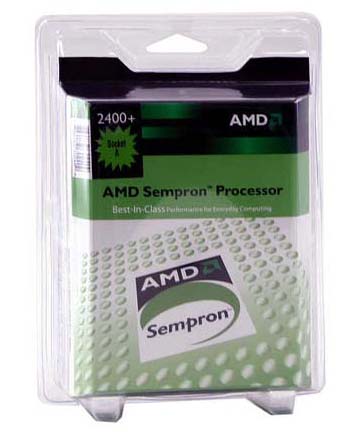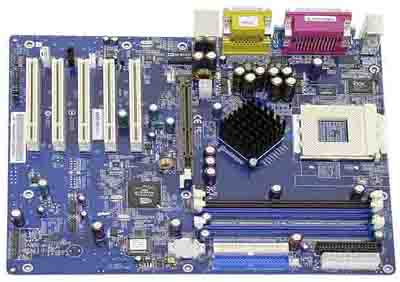Buyer's Guide - Entry Level, October 2004
by Jarred Walton on October 6, 2004 12:05 AM EST- Posted in
- Guides
CPU and Motherboard: Budget Office
For many years, if you wanted to keep up with computing trends you had to be willing to upgrade. This could range from replacing a few parts to purchasing an entirely new system. While that might not be a problem for some, for others it was a difficult proposition. Back in the 80s and 90s, buying a new computer every year or two could cost as much as a used automobile (although reliability might be a concern). Thankfully - depending on whom you ask - things have started to slow down. Many businesses continue to run two or three year old PCs with no real need to upgrade. Any processor running 1 GHz or faster is more than sufficient for surfing the net, writing email, and doing miscellaneous office work. It may not set any speed records, but other than an initial delay while starting up, most office applications spend most of their time waiting on the user.
Office CPU: AMD Sempron 2400+ 256K 1.67 GHz 333 MHz bus
Price: $65 shipped (Retail)
Our recommendation for this month's budget CPU goes to the AMD Sempron 2400+. The Sempron is basically a tweaked version of the venerable Athlon XP Thoroughbred core. Do not let the names confuse you; the Sempron family is meant to compete with the Intel Celeron line of processors and it actually runs at the same speed as the Athlon XP 2000+. However, the Sempron does use a faster 333 MHz bus, which can improve performance slightly, and since the two chips are basically the same price, there is little reason not to opt for the faster bus.
Should you wish to spend a little more on a faster processor, the Athlon XP 2500+ is still a reasonable purchase at roughly $25 more than the Sempron 2400+. It increases clock speed and doubles the amount of cache. However, AMD has recently started to phase out the Athlon XP processors and shift production to the Sempron and Athlon 64 lines, so Athlon XP prices are starting to rise. If you really want to pick up a Barton core Athlon XP, we recommend that you act sooner rather than later - the 2500+ has gone from a low of $75 a few months back to $90.
The Celeron D processor from Intel is also available at relatively low prices, but the price/performance ratio is usually lower than Athlon XP/Sempron. For those who simply have to run an Intel CPU, they are a reasonable alternative. Intel motherboards also tend to cost a little more, so the net result is that $20 will buy a Celeron D 320 and i865PE motherboard which may be slightly faster than the Sempron 2400+. The same $20 would also buy an Athlon XP 2500+, which would be another bump up in speed from the Celeron D 320. We recommend that you stay away from the older Celeron processors, however, as they use a slower bus and have 128K of L2 cache, which really hurts their performance.
Choosing a motherboard in this price segment is extremely difficult. Socket A has been around for over four years now and there have been dozens of chipsets both with and without integrated graphics. If saving money is your top priority, you might want to find an Nforce2 IGP motherboard, as it remains to this day to be one of the best integrated graphics solutions. Prices for these motherboards tend to be around $70 to $80. You will also find numerous refurbished motherboards available at a discount, but we prefer to stick with new models with their longer warranties.

Office Motherboard:Shuttle AN35N-Ultra
Price: $58 shipped
Shuttle gets the nod for our budget motherboard this time, as it includes more high-end features while still providing good reliability and performance. There may be other motherboards that are 1 or 2% faster, but they tend to cost more. The Shuttle features the more advanced Nforce2 Ultra chipset, which provides support for dual-channel memory. Should you be willing to spend a little more money, there are dozens of other motherboards that will work equally well and include additional features like SATA, IEE1394 (Firewire), RAID, and higher quality audio. However, none of those features are necessary and they increase the price slightly.
Update: If you read this guide earlier, you may have seen the Asus A7N8X-X recommended. Some of our readers were good enough to remind us that this board does not support dual-channel RAM. While it might only make a 3 to 5% difference in performance, the Shuttle supports this feature and costs less, and we have no problem wiht recommending it as in place of the ASUS. Abit, Albatron, ASRock, Chaintech, MSI, and quite a few other companies provide good motherboards at very low prices. The only feature that we still insist on for any socket A motherboard is that it use an Nforce2 chipset. Not even the new KT880 is able to fully match the performance of the Nforce2, and since they remain roughly the same price, why settle?










53 Comments
View All Comments
Gholam - Wednesday, October 6, 2004 - link
Why not use an nForce2 IGP or KM400 based board and dump the discrete graphics card? Also, $73 case for an office system is waaaaay too expensive - an HEC 6CS3 with a 300W PSU will run you $30-35.Scarceas - Wednesday, October 6, 2004 - link
Ozenmacher - Wednesday, October 6, 2004 - link
I think for a budget office system, someone staring at a monitor all day may appreciate an LCD since they generally have better text and do not flicker. In that case, you can find 15 in LCD's online close to 200 dollars with integrated speakers. While integrated speakers suck, they would suffice for the office user and would reduce clutter. In that case, maybe another recommendation would be to subtract the 16 dollar speakers and add a little money towards an LCD for a slightly higher price. If they are really hurting for money, they definitely could subtract the video card as well.ceefka - Wednesday, October 6, 2004 - link
I second that #8. I like this new style too. Thank you Jarred for going the extra mile.Zebo - Wednesday, October 6, 2004 - link
#7 the best kept secret in ram is the crucial 8T, which Mwave sells also in thier bundles. This stuff can and will clock to 250 Mhz FSB and low timings. 3-3-3 1T. I've talked about it in various threads before and pointed here: http://www.ocforums.com/showthread.php?t=328636to show it's outstanding charachteristics.
Zebo - Wednesday, October 6, 2004 - link
Excellent work Jarred.I really like the idea of and your explinations of "alternative" goods. Like the monitor, 512 ram and 9800 pro. It gives users who may value of aspect or another, while considering thier intended use, some good clues.
DrMrLordX - Wednesday, October 6, 2004 - link
Interesting guide. I may follow some, if not all of these recommendations soon, if I can actually bear to part with money for a new system anytime soon.I was wondering if you've noticed mwave.com's deals on the Chaintech board you recommended, paired with Athlon 64s and Kingston memory(I think they have a few other brands available). The price on the three components together is very cheap, and could serve as an excellent base for a budget gamer(or overclocker) system.
You can get the above-mentioned combo(the RAM is 1x512 megs Kingston PC3200) for $292 + shipping. You get a free Farcry thrown in as well, and you get a better CPU than the Sempron 3100+.
Also, AMD is reportedly going to be dropping prices across the board on Oct 15. Best to wait 'til then if you're going to buy an AMD system.
ilancas - Wednesday, October 6, 2004 - link
JarredWalton - Wednesday, October 6, 2004 - link
Calin, certain flash USB devices can apparently be configured to function in place of a floppy drive. At least, that's what I've heard - I have never actually used one personally. Like I said in the article, it's worth the $10 for me. :DCalin - Wednesday, October 6, 2004 - link
"and installing hard drive controllers for XP are a couple of examples that often benefit from the presence of a floppy drive"Hello, there is no other way to install a driver for an unusual controller - even in Windows 2003. If you don't have a floppy, you're out of luck
Calin